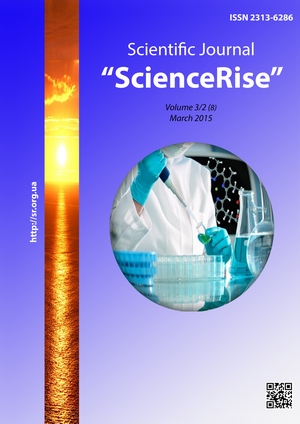Model representation for formation of frontal porous silicon layers for solar cells
DOI:
https://doi.org/10.15587/2313-8416.2015.39154Keywords:
antireflective coating, porous silicon, model representation, electrochemical etching, solar cellAbstract
For obtaining the frontal functional layers of solar cells (SC) was made deep analysis of existing models of porous silicon. The selected models are most effective to create an efficient and cost-effective coating on porous silicon and best adapted to the processes of creating silicon solar cells. Using layers of porous silicon obtained from the model representation simplify the work cycle, reduce product cost and improve performance that will increase the efficiency of manufacturing technology of solar cells
References
Liena, S.-Y., Wuua, D.-S., Yeh, W.-C. (2006). Tri-layer antireflection coatings (SiO2/SiO2–TiO2/TiO2) for silicon solar cells using a sol–gel technique. Solar Energy Materials & Solar Cells, 90 (16), 2710–2719. doi: 10.1016/j.solmat.2006.04.001
Canham L. T. (1990). Porous silicon multilayer optical waveguides. Appl. Phys. Lett, 57, 1046.
Prokes, S. M., Glembocki, O. J., Bermudez, V. M., Kaplan, R. (1992). SiHx excitation: An alternate mechanism for porous Si photoluminescence. Physical Review B, 45 (23), 13788. doi: 10.1103/physrevb.45.13788
Brandt, M. S., Fuchs, H. D., Stutzmann, M., Weber, J., Cardona, M. (1992). Structural and Optical Properties of Porous Silicon Nanostructures. Solid State Commun, 81, 307.
Koch, F. (1993). Porous Silicon: Material, Technology and Devices. Mater. Res. Sot. Symp. Proc., 298, 319.
Witten, T. A., Sander, L. M. (1983). Diffusion-limited aggregation. Physical Review B, 27 (9), 5686–5697. 10.1103/physrevb.27.5686
Smith, R. L., Collins, S. D. (1989). Generalized model for the diffusion-limited aggregation and Eden models of cluster growth. Physical Review A, 39 (10), 5409–5413. doi: 10.1103/physreva.39.5409
Parkhutik, V. P., Shershulsky, V. I. (1992). Theoretical modeling of porous oxide growth on aluminium. Journal of Physics D: Applied Physics, 25 (8), 1258–1263. doi: 10.1088/0022-3727/25/8/017
Carstensen J., Prange, R., Foil, H. (1999). A model for current-voltage oscillations at the silicon electrode and comparison with experimental results. Journal of The Electrochemical Society, 146 (3), 1134–1140. doi: 10.1149/1.1391734
Valance, A. (1997). Theoretical model for early stages of porous silicon formation from n- and p-type silicon substrates. Physical Review B, 55 (15), 9706–9715. doi: 10.1103/physrevb.55.9706
Kang, Y., Jorne, J. (1997). Dissolution mechanism for p-Si during porous silicon formation. Journal of The Electrochemical Society, 144 (9), 3104–3110. doi: 10.1149/1.1837966
Chazalviel, J.-N., Wehrspohn, R. B., Ozanam, F. (2000). Electrochemical preparation of porous semiconductors: from phenomenology to understanding. Materials Science and Engineering (B), 69-70, 1–10. doi: 10.1016/s0921-5107(99)00285-8
Emel'yanov, V. I., Eremin, K. I., Starkov, V. V. (2002). Defect-deformation mechanism of spontaneous nucleation of an ensemble of pores in solids and its experimental verification. Quantum Electronics, 32 (6), 473–475. doi: 10.1070/qe2002v032n06abeh002225
Emel'janov, V. I. (1999). Samoorganizacija uporjadochennyh defektno-deformacionnyh mikro- i nanostruktur na poverhnosti tverdyh tel pod dejstviem lazernogo izluchenija. Kvant, jelektronika, 27 (7), 2–18.
Walgraef, D., Ghoniem N. М., Lauzeral, J. (1997). Deformation patterns in thin films under uniform laser irradiation. Physical Review B, 56 (23), 15361–15377. doi: 10.1103/physrevb.56.15361
Emel'yanov, V. I. (1992). Generation-Diffusion-Deformational Instabilities and Formation of Ordered Defect Structures on Surfaces of Solids under the Action of Strong Laser Beams. Laser Physics, 2 (4), 389–466.
Lehmann, V. (1993).The physics of macropore formation in low doped n-type silicon. Journal of The Electrochemical Society, 140 (10), 2836–2843. doi: 10.1149/1.2220919
Lehmann, V., Ronnebeck, S. (2004). The physics of macropore formation in low-doped p-type silicon. Journal of The Electrochemical Society, 146 (8), 2968–2975. doi: 10.1149/1.1392037
Zhang, X. G. (2004). Morphology and Formation Mechanisms of Porous Silicon. Journal of The Electrochemical Society, 151 (1), 69–80. doi: 10.1149/1.1632477
Lehmann, V., Gosele, U. (1991). Porous silicon formation: A quantum wire effect. Applied Physics Letters, 58 (8), 856–858. doi: 10.1063/1.104512
Kompan, M. E., Kuzminov, E. G., Kulik, V. (1996). Observation of a compressed state of the quantum wire material in porous silicon by the method of Raman scattering. Journal of Experimental and Theoretical Physics Letters, 64 (10), 748–753.
Starkov, V. V., Starostina, E. A., Vyatkin, A. F., Volkov, V. T. (2000). Dielectric porous layer formation in Si and Si/Ge by local stain etching. Physica status solidi (a), 182 (1), 93–96. doi: 10.1002/1521-396x(200011)182:1<93::aid-pssa93>3.0.co;2-8
Yerokhov, V. Yu., Melnyk, I. I. (1999). Porous silicon in solar cell structures: A review of achievements and modern directions of further use . Journal: Renewable and Sustainable Energy Reviews, 3 (4), 291–322. doi: 10.1016/s1364-0321(99)00005-2
Huang, Y., Ma, Q.-L., Meng, M. (2011). Porous silicon based solar cells. Materials Science Forum, 663-665, 836–839. doi: 10.4028/www.scientific.net/msf.663-665.836
Foil, Н., Christophersen, М., Carstensen, J., Hasse, G. (2002). Formation and application of porous silicon. Materials Science and Engineering (R), 39, 93–141.
Downloads
Published
Issue
Section
License
Copyright (c) 2015 Валерій Юрійович Єрохов

This work is licensed under a Creative Commons Attribution 4.0 International License.
Our journal abides by the Creative Commons CC BY copyright rights and permissions for open access journals.
Authors, who are published in this journal, agree to the following conditions:
1. The authors reserve the right to authorship of the work and pass the first publication right of this work to the journal under the terms of a Creative Commons CC BY, which allows others to freely distribute the published research with the obligatory reference to the authors of the original work and the first publication of the work in this journal.
2. The authors have the right to conclude separate supplement agreements that relate to non-exclusive work distribution in the form in which it has been published by the journal (for example, to upload the work to the online storage of the journal or publish it as part of a monograph), provided that the reference to the first publication of the work in this journal is included.

